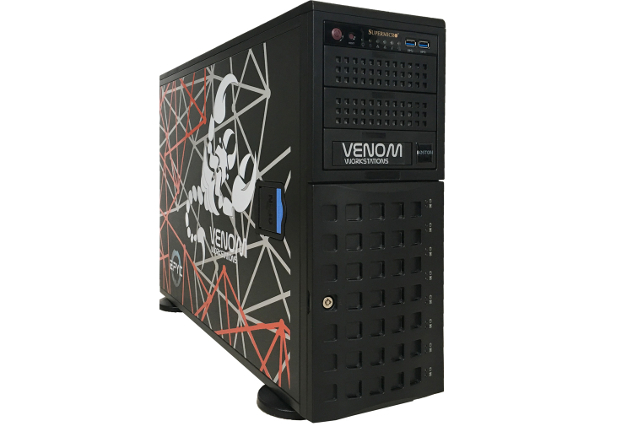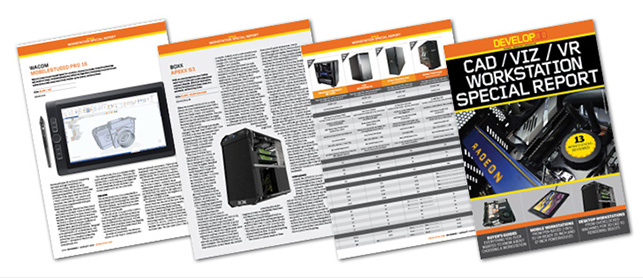The Boston Venom Epyc offers dual 32 core AMD Epyc CPUs, but at the expense of single threaded performance, writes Greg Corke
AMD’s resurgence in the CPU sector may be characterised by its Ryzen and Threadripper processors but, when it comes to multi-threaded brute force, it’s the lesser known Epyc CPU that wins hands down. With up to 32 cores (and 64 threads) per CPU and two CPUs per machine, it promises the kind of processing power that most digital artists who use ray trace renderers can only dream of.

AMD Epyc is primarily designed for servers and datacentres. However, because of the sheer number of cores it’s also starting to make its way into workstations.
We got our hands on a pre-production version of the Boston Venom Epyc, which was configured with dual AMD Epyc 7551 CPUs. With 32 cores and 64 threads in each processor, it has massive potential for multi-threaded workflows. However, to get this kind of core density in a 180W chip, there’s a trade off in frequency and the CPU runs at a base of 2.0GHz, with an all core boost speed of 2.55GHz and a max turbo of 3.0GHz.
We first tested the machine in a workflow where it was destined to excel. And right on cue, it delivered our Luxion KeyShot render in a phenomenal 95 seconds, just a second slower than the dual Intel Xeon Gold 6154 Armari R80 workstation. It also completed the V-Ray benchmark in 21 seconds, which puts it in the top ten highest scores on the public chart.
During these short tests, we observed the CPU frequency stayed close to the ‘all core boost speed’ of 2.55GHz. But those who invest in a machine like this rarely let it go idle for long and during sustained renders the frequency dropped to 2.3GHz.
Of course, workstations also need to perform single threaded operations, which is important for general modelling and system performance.
Even with the CPU operating at 3.0GHz it came bottom in our single threaded SolidWorks IGES model export test and was notably 47% slower than the Armari R80 with two Intel Xeon Gold 6154 CPUs clocked at 3.7GHz.
Boston Venom Epyc – Product specifications
■ 2 x AMD Epyc 7551 (2.0GHz, 3.0GHz Turbo) (32 cores, 64 threads)
■ 256GB (16 x 16GB) DDR4 ECC REG 2,666MHz
■ AMD Radeon Pro WX 7100 (17.Q4 driver)
■ 512GB Samsung 960 Pro M.2 NVMe SSD + 240GB Intel SSD DC S3520 Series
■ Supermicro H11DSi-NT
■ 452 x 178 x 647mm / N/A
■ Microsoft Windows Server 2016
■ Standard 3 year return to base
CPU benchmarks (single threaded) – Seconds (smaller is better)
SolidWorks 2015 IGES export: 170
CPU benchmarks (multi-threaded) – Seconds (smaller is better)
Luxion KeyShot 6.1 render test: 95
V-Ray CPU rendering benchmark (CPU): 21
GPU compute benchmark – Seconds (smaller is better)
V-Ray render benchmark (GPU): 254
3D graphics benchmarks (3D CAD) – Score (bigger is better)
SPECapc for SolidWorks 2015 (shaded + edges): N/A (benchmark not compatible with OS)
SPECapc for SolidWorks 2015 (RealView + shadows): N/A (benchmark not compatible with OS)
SPECapc for SolidWorks (RealView + shadows + AO): N/A (benchmark not compatible with OS)
SPECapc for PTC Creo 3.0 (shaded + edges): N/A (benchmark not compatible with OS)
SPECapc for PTC Creo 3.0 (reflection): N/A (benchmark not compatible with OS)
3D graphics benchmarks (design viz) – Frames Per Second (FPS) (bigger is better)
LumenRT (hotel model) (FPS): 31
LumenRT (roundabout model): 15
Autodesk LIVE (Villa Enhanced model): 84
Autodesk VRED Professional (AA off): 36
Autodesk VRED Professional (AA medium): 16
Autodesk VRED Professional (AA ultra high ): 6
3D graphics benchmarks (VR) – Frames Per Second (FPS) (bigger is better)
VR Mark (Orange): 129.24
VR Mark (Blue): 22.82
VR Mark (Cyan): 63.06







